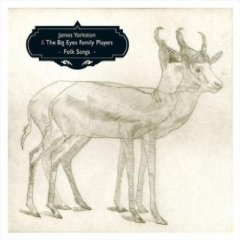Anna Murray posted on September 18, 2009 19:00
A review of the album Folk Songs by James Yorkston and the Big Eye Family Players

Review Snapshot: An almost ideal combination of ye olde tunes with contemporary musical sensibilities, Yorkston and friends have created an album that is interesting and near irresistible.
The Cluas Verdict? 8 out of 10
Full Review:
The title of this album is not only apt for its content, but also for its mood. Folk Songs, in title and nature, is simple, unassuming and charmingly frank. With eleven traditional tracks, it is an album of genuine grass-roots folk, marking it as occupying a different sphere to the Bob Dylans and modern folk artists. The question in listening to such as album is whether or not to hear it as part of, and on the same page as, the indie rock – or even folk rock – institution, or hear and value it as part of something separate, that of folk and traditional.
The answer lies somewhere in the middle: Yorkston and Green's arrangements of these songs give them both historical and contemporary relevance, and serve to create a overall exploration of the potential for the modernisation of traditional folk from beginning to end. In almost every instance Yorkston and co. retain the melody, rhythm, style, modality and even fal-do-ral refrains of the original, but place them in a new context through creative instrumentation, enveloping gentle tunes in an unexpectedly edgy environment.
Opener ‘Hills of Greenmoor' is an embodiment of uncomplicated and (semi-) authentic folk simplicity, with a simple guitar picking pattern creating the traditional drone and later doubling the melody, a low-key instrumental refrain, and minimal percussion. ‘Just as the Tide is Flowing' is even less dense, with only the guitar remaining, still providing a simple pattern and drone, while a female voice ornaments a gracefully nursery rhyme-like melody with a simple descant. The third track, a bard's tale of a girl disguising herself as a soldier, sees things pick up a little with the first instance of prominent percussion, and a certain extra life to the guitar drone and instrumental refrains. However, from here on is where the lines truly become blurred: ‘Mary Connaught and James O'Donnell' with its quick-moving harmony, quick marching drumbeat, lively guitar, subtle backing vocals and the addition of more low-mix, non-lead instruments betrays its origins as a tune newly-composed for a traditional lyric.
For the remainder we see modern values try to commandeer the album, usurping those of folk. A poacher's ballad is enveloped in a environment of soft rolling cymbals and toms, the strings echoing the voice in an arresting overall swell, culminating the totally unexpected entrance of string sounds creating an alien effect like distortion and feedback, adding a layer of unease. ‘I Went to Visit the Roses' – also a new air to an old lyric – shows a more subtle blend of instruments, even verging on riffing, while the minimalism of ‘Sovay', despite its unmistakable modal harmony, positions it closer to Mark Lanegan than trad.
James Yorkston, along with the Big Eyes Family Players, has not only tried to redefine folk for a modern audience, but the musician's and "songwriter's" role as the medium between history and listener, finding the perfect balance between retelling and interpreting, faithfulness and creativity.
Anna Murray
More ...
[Read More...]